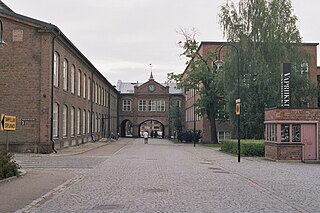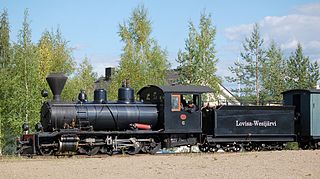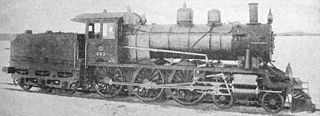
VR-Group Plc, commonly known as VR, is a government-owned railway company in Finland. VR's most important function is the operation of Finland's passenger rail services with 250 long-distance and 800 commuter rail services every day. With 7,500 employees and net sales of €1,251 million in 2017, VR is one of the most significant operators in the Finnish public transport market area.

Oy Tampella Ab was a Finnish heavy industry manufacturer, a maker of paper machines, locomotives, military weaponry, as well as wood-based products such as packaging. The company was based mainly in the Naistenlahti district of the city of Tampere.

The Jokioinen Museum Railway is located in Jokioinen, Finland. It is located on the last operating commercial narrow gauge railway in Finland, the 750 mm gauge Jokioinen Railway.

The VR Class Hr11 was the first class of line-haul diesel locomotives used by Valtionrautatiet. Only five units were built, all delivered by Valmet in 1955. The Maybach diesel engines used in the locomotives proved highly unreliable, resulting in a complete overhaul of the engine-transmission system in 1956–58, but this did not solve all of the reliability problems. The Hr11 series was withdrawn from service in 1972.

The Hr1 class was the largest passenger express steam locomotive built in Finland. Twenty-two were built between the years 1937–1957. They were numbered 1000–1021.

The Finnish VR Class Tk3 was a 2-8-0 light freight locomotive. It was the most numerous steam locomotive class in Finland with 161 built. 100 locomotives were constructed between 1927 and 1930, with a further 61 ordered and constructed 1943–53. They were numbered 800–899, 1100–1118, and 1129–1170.

VR Class Pr1 was a tank steam locomotive for local passenger services of Finnish railways.

The Finnish VR Class Hv1 was a 4-6-0 express passenger train locomotive. 42 were built between 1915 and 1921. They were numbered 545–578 and 648–655.

Before 1942 VR Class Vr1s originally had the class name was L1. The Vr1 was a powerful and effective locomotive. Part of them were built by Tampella and part by Hannoversche Maschinenbau AG of Germany. They were numbered 530–544, 656–670, 787–799 and were nicknamed “Kana” ("Hen"). They were operation from 1913-1974.

The VR Class Vr3 was a class of steam locomotive built in Finland. Before 1942, the class was known as O1. They were nicknamed Kukko and they have the same frames and boiler as the Vr Class Pr1 (Paikku) locomotive. The first locomotive was ordered in 1924 from Hanomag of Germany, number 10 351 and it was numbered 752. The remaining 4 were produced by Tampella Oy in Tampere. They were numbered 752 to 756.

The VR Class Tr1 is a class of heavy freight locomotive built in Finland and Germany. Before 1942 VR Class Tr1s originally had the class name R1. They were nicknamed “Risto”, after the Finnish President Risto Ryti. They were numbered 1030–1096.

The locomotive that came to form VR Class Vk4 was originally one of a pair of 0-4-0T locomotives ordered from Rheinmetall Borsig Lokomotiv Werke (AEG), Germany to work at Ino fortress at Terijoki on the Karelian Isthmus. The locomotives had 2 axles, they were the wet-steam type, and used a slip-Walschaert valve gear. Production numbers and years were 7268/1909 and 7858/1910. The fortress was in Finnish hands when Finland became independent.

The Finnish VR Class Pr2, nicknamed "Henschel", was a passenger tank class ordered from the Henschel & Son locomotive workshops by the Estonia State Railways in the spring 1939 and completed in 1941. The outbreak of the Second World War prevented their delivery to Estonia, but at least a few of these engines did manage to operate in Latvia in 1942. These engines became superfluous, because the Germans were converting the Baltic tracks to standard gauge, and so Finland could purchase these four engines. They were classified Pr2 and numbered 1800–1803 after their arrival in December 1942.

VR Class Dr12 was a heavy diesel-electric locomotive of Valtionrautatiet. The first 6 locomotives were ordered in 1956. They entered service between 1959 and 1963. The locomotives were built by 2 manufacturers, Valmet and Lokomo, both based in Tampere. All Hr12 class locomotives with even numbers were produced by Valmet, while all odd numbers were produced by Lokomo. The locomotives were withdrawn in the early 1990s.

VR Class Dr13 was a heavy diesel locomotive used by VR Group. The Dr13 was designed by the French company Alstom. The class consisted of 54 locomotives, of which the first two were built by Alstom’s factory in Belfort, France and were shipped to Finland in 1962, while the rest were built in Tampere at the factories of Lokomo and Valmet. The first Dr13 series locomotive came to Finland on 24 October 1962. The Dr13 series was introduced between 1962–1963, and the last units were withdrawn by June 2000.

Finnish Steam Locomotive Class F1 was a class of tank locomotives, which did not have to be turned at terminal stations. The water tank was located below the space behind the cab, in contrast to more modern tank locomotives where the water tanks usually placed either side of or on top of the boiler.

The VR Class Ds1 Also known as "Puumotti" was the first railbus of the Finnish State Railways. It was ordered in 1927. The Ds1 was built by the Pasila workshop, but the automotive parts including the engine were supplied by the Swedish company DEVA. Ds1 has a diesel engine and an electric drive, with a diesel generator providing power to the wheels. A cab is at either end of the vehicle, so that the vehicle did not have to be turned at terminal stations. The vehicle consisted of a motor room, a luggage compartment, and a 3rd class passenger compartment bare on a wooden bench seating.

The VR Class Vk11 No 101 locomotive was purchased for testing on a six-mile stretch of track between Vuokatti and Sotkamo, where the use of steam locomotives had proved to be uneconomical due to low traffic. The locomotive was ordered from the Swedish act called Ab Slipmaterial of Sweden, and it was completed in 1930. The locomotive had a six-litre Wisconsin petrol-paraffin internal-combustion engine. In January 1931 the locomotive was delivered to Finland, it initially received the number Mt 101. Another very similar locomotive was ordered home in 1935. It was built by Lokomo in Finland and had an 80 hp paraffin Andros petrol-paraffin engine. It initially received the number Mt 102. In 1953 locomotive class designation was changed to Vk11, and in 1962 they were renumbered again to Tve-ko1 and Tve-ko2. Vk11 locomotives were broadly similar to each other, but there were a number of detail differences. Both were two-axle and weighing 12 tons. Both had engines that ran on kerosene / paraffin as fuel but required gasoline / petrol to start them. Locomotives had different lengths of 5.6 m and 6.0 m. Locomotive Vk11 No. 101 was tested on Vuokatti-Sotkamo line for four months. When the passenger rail in this case was discontinued, it was transferred to the locomotive workshop in Oulu on internal traffic. In 1935, the locomotive was placed in a shunting yard in Siuro. After that the locomotive was used at Vaasa and the workshop at Oulu as a shunter. The locomotive was withdrawn in 1962.


















